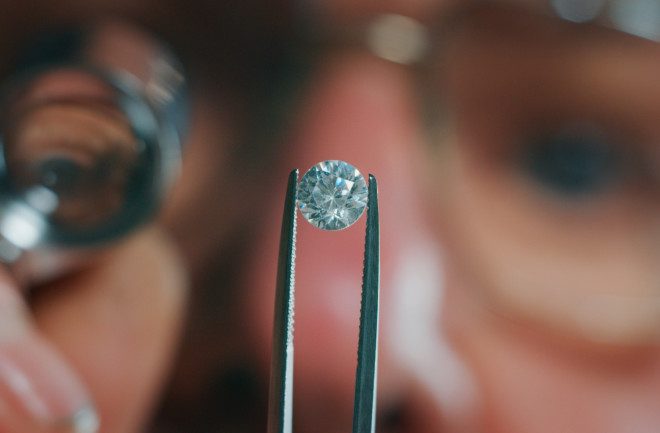Lab-grown diamonds are not exactly new to the scene. But if you haven’t heard the term before, they are chemically and physically the same as their natural counterparts. This is without the hefty price tag that can cost anywhere from ten to thousands of dollars. A lab-grown diamond is essentially a real diamond in every way. It’s created with strict scientific processes that mimic nature, refined until each stone becomes perfect, and its brilliance rivals that of mined diamonds.
Lab Grown Diamonds Definition
What is a lab grown diamond? Lab grown diamonds are artificial diamonds produced in a lab. They look exactly like the real thing and can be just as valuable, but they are much more eco-friendly. These gems are produced by taking carbon from the air and transforming it into diamonds under intense pressure and heat. The process is similar to that used to create synthetic rubies, sapphires, and emeralds. But, while these other gems are created by adding chemicals to a crystal, lab grown diamonds are created using pure carbon extracted from coal or graphite. The resulting material is then heated until it melts and then cools down to form diamond crystals.
The History of Lab Grown Diamonds
Lab grown diamonds are not a new invention but a relatively new addition to the jewelry market. The first lab grown diamond was created in the 1950s by scientists at General Electric. They were trying to create synthetic stones that would be resistant to corrosion and have durability similar to that of diamonds but with much less value. But, they were unsuccessful in their experiments until they accidentally stumbled upon the process of growing diamonds inside a vacuum chamber.
Growing these manufactured gems involves placing a seed diamond into an oxygen-free environment where it is bombarded with carbon atoms. This process takes several months and results in a chemically identical stone to natural diamonds.
The history of lab grown diamonds can be traced back to this discovery. It’s as far back as the Roman Empire when people began using crushed quartz instead of natural gemstones for their jewelry due to their low cost compared with their natural counterparts.
How are Lab Created Diamonds Created?
Creating a lab grown diamond starts with a piece of pure carbon. The carbon is placed under extreme heat and pressure to form a diamond. Other methods used to create diamonds use plasma or chemical vapor deposition. Both of these methods use high temperatures and pressure but differ from HPHT.
High Pressure, High Temperature – HPHT
This process was first conceived in the early 1900s and was used to grow diamonds for industrial purposes. Yet, it wasn’t until the 1980s that scientists began using HPHT growth methods to produce gem-quality diamonds. Today, most lab grown diamonds are made using this method.
In an HPHT system, carbon atoms are placed into a pressurized chamber with a gas source at high temperatures. The gas source supplies hydrogen atoms which combine with carbon atoms to form a diamond structure. When the desired size is reached, the newly grown diamond is removed from the chamber and cooled down so it can be cut into gemstones.
Chemical Vapor Deposition -CVD
Lab grown diamonds are produced in a lab using chemical vapor deposition CVD. In this process, a carbon seed crystal is placed inside a vacuum chamber. Carbon atoms are heated to up to 2,500 degrees Celsius and combined with hydrogen gas and methane gas CH4 under high pressure and in an argon gas atmosphere. The combination causes the growth of diamond crystals. The diamonds are then cut and polished for sale as gemstones.
The process works because of the unique properties of carbon. It’s highly stable. It has a tetrahedral structure, a shape with four triangles, and it’s very hard. This makes it ideal for use as an abrasive or cutting tool. Since antiquity, it has also been used as jewelry because it can be worked into beautiful shapes and colors that other minerals cannot achieve.
Are Lab Grown Diamonds Ethically Responsible?
Lab grown diamonds are an ethical choice because they do not harm anyone or anything in the process of their creation. Unlike conventional mined diamonds, these stones are not mined from the earth, which causes environmental damage and human rights violations.
Lab grown diamonds are created in a controlled environment by scientists, so they don’t cause any harm to humans or other living things. There’s no need for human labor or child labor. Plus, lab grown diamonds create no waste, unlike mined diamonds which cause pollution through mining and manufacturing processes.
The mining of natural diamonds is extremely damaging to the environment and can result in human rights violations. There have been many documented cases of forced labor, child labor, and slavery in diamond mines around the world.
Benefits of Lab Created Diamonds
Lab grown diamonds are an alternative to mined diamonds. Lab grown diamonds are created using high-pressure, high-temperature HPHT technology. Besides being environmentally friendly, lab grown diamonds come with many benefits. Here are just a few of the reasons why you might want to consider buying one:
- They’re less expensive than mined diamonds. Since they’re made in labs instead of dug up from the earth, they don’t require as much time or money to produce. This means that they tend to be less expensive than natural diamonds.
- You can customize them how you’d like. You can choose what your diamond will look like, from its cut and color to its clarity and carat weight. This is especially helpful if you want a diamond that’s not easily available in nature, for example, a blue diamond.
- They have fewer flaws than mined diamonds because they’re grown under controlled conditions in labs.
In Conclusion
Next time you’re looking for a new type of stone for that special necklace or ring, pick up something that everyone won’t expect: an exquisite lab grown diamond. As you can see, lab created diamonds are a wonderful alternative to the traditionally mined diamond. Whether it’s affordability or environmental friendliness, lab grown and mined diamonds provide the same value to you as a consumer. Your decision should be based on personal preference, not on some notion of what makes a real diamond.


0 comments